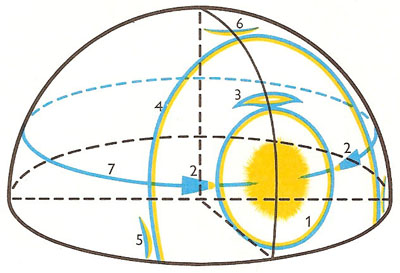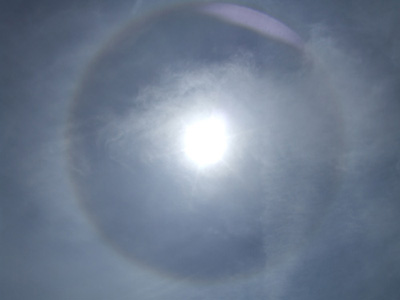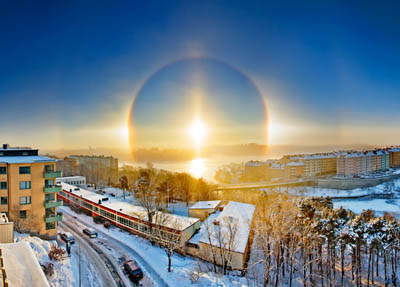atmospheric halo

Halo phenomena may take many forms. Besides the common 22° halo (1) we may sometimes see parhelia ("mock suns"), luminous spots about 22° on either side of the Sun (2). A tangent arc (3) is often associated with the 22° halo. (4) The large, less luminous halo with an angular radius of 46°; (5) the tangent arc to the 46° halo; and (6) the circumzenithal arc, centered on the zenith and parallel to the horizon. The parhelic circle ("mock sun ring"), which passes through the Sun and may extend completely across the sky is seen at (7).

22° solar halo. Image credit: Jeff Darling.

22° Parhelia, photographed in Stockholm in 2010. Most prominent when the Sun is low, parhelia, also called "sundogs," are visible all over the world and tend to form in high and cold cirrus clouds. They are caused by light shining through ice crystals, which act like a multitude of tiny lenses. Image credit: Peter Rosen.
An atmospheric halo is a phenomenon that can range in appearance from a simple and fairly common circle of light around the Sun or the Moon to a rare event in which the whole sky is webbed by intricate arcs. Atmospheric halos are caused by tiny, flat ice crystals in the atmosphere that refract and reflect incoming light. Round solar halos with a radius of 22° happen more often than rainbows, and in Europe and parts of the United States can be seen on average twice a week.
Within a solar halo, on opposite sides of the Sun and at the same altitude, may be two bright spots known as parhelia, sundogs, or mock suns. Lunar halos may contain parselenae, or mock moons, but these are usually seen only in polar regions and within five days of a full moon.


